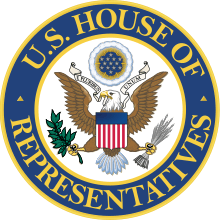Plural district
A plural district was a district in the United States House of Representatives that was represented by more than one member. States using this method elected multiple members from some of their geographically defined districts, either on a single ballot (block voting) or on separate concurrent ballots for each seat (conducting multiple plurality elections).
| This article is part of a series on the |
| United States House of Representatives |
|---|
 Great Seal of the United States House of Representatives |
|
History of the United States House of Representatives |
| Members |
|
|
| Politics and procedure |
|
| Places |
This method was used to give more populous counties additional representation without dividing them into multiple districts - voters were instead allowed to either vote in several elections or to vote for a slate of candidates. It was a system used mostly in Maryland, New York and Pennsylvania until prohibited by the 1842 Apportionment Bill and subsequent legislation.
Plural district usage
This is a table of every instance of the use of plural districts in the United States Congress
| Congress | State & Number of Representatives (District numbers) |
|---|---|
| 3rd | MA-13 (#1,2,3,4) |
| 4th | PA-2 (#4) |
| 5th | PA-2 (#4) |
| 6th | PA-2 (#4) |
| 7th | PA-2 (#4) |
| 8th | MD-2 (#5), PA-8 (#1,2,3,4) |
| 9th | MD-2 (#5), NY-2 (#2,3), PA-8 (#1,2,3,4) |
| 10th | MD-2 (#5), NY-2 (#2,3), PA-8 (#1,2,3,4) |
| 11th | MD-2 (#5), NY-4 (#2,6), PA-8 (#1,2,3,4) |
| 12th | MD-2 (#5), NY-4 (#2,6), PA-8 (#1,2,3,4) |
| 13th | MD-2 (#5), NJ-6 (#1,2,3), NY-12 (#1,2,12,15,20,21), PA-14 (#1,2,3,5,6,10) |
| 14th | MD-2 (#5), NY-12 (#1,2,12,15,20,21), PA-14 (#1,2,3,5,6,10) |
| 15th | MD-2 (#5), NY-12 (#1,2,12,15,20,21), PA-14 (#1,2,3,5,6,10) |
| 16th | MD-2 (#5), NY-12 (#1,2,12,15,20,21), PA-14 (#1,2,3,5,6,10) |
| 17th | MD-2 (#5), NY-10 (#1,2,12,15,20), PA-14 (#1,2,3,5,6,10) |
| 18th | MD-2 (#5), NY-7 (#3,20,26), PA-14 (#4,7,8,9,11,16) |
| 19th | MD-2 (#5), NY-7 (#3,20,26), PA-14 (#4,7,8,9,11,16) |
| 20th | MD-2 (#5), NY-7 (#3,20,26), PA-14 (#4,7,8,9,11,16) |
| 21st | MD-2 (#5), NY-7 (#3,20,26), PA-14 (#4,7,8,9,11,16) |
| 22nd | MD-2 (#5), NY-7 (#3,20,26), PA-14 (#4,7,8,9,11,16) |
| 23rd | NY-12 (#3,8,17,22,23), PA-5 (#2,4) |
| 24th | MD-2 (#4), NY-12 (#3,8,17,22,23), PA-5 (#2,4) |
| 25th | MD-2 (#4), NY-12 (#3,8,17,22,23), PA-5 (#2,4) |
| 26th | MD-2 (#4), NY-12 (#3,8,17,22,23), PA-5 (#2,4) |
| 27th | MD-2 (#4), NY-12 (#3,8,17,22,23), PA-5 (#2,4) |
See also
Sources
- Martis, Kenneth C. (1982). The Historical Atlas of United States Congressional Districts. New York: Macmillan Publishing Company.